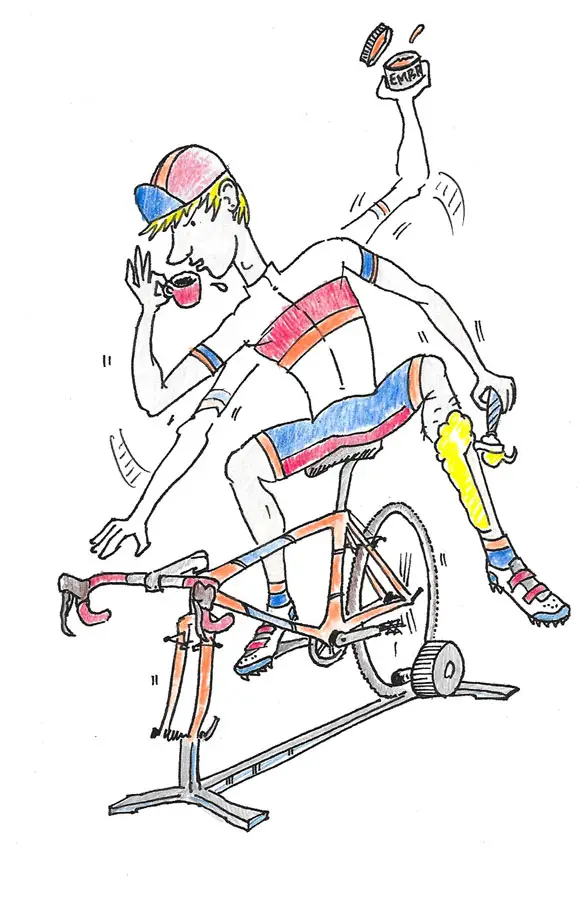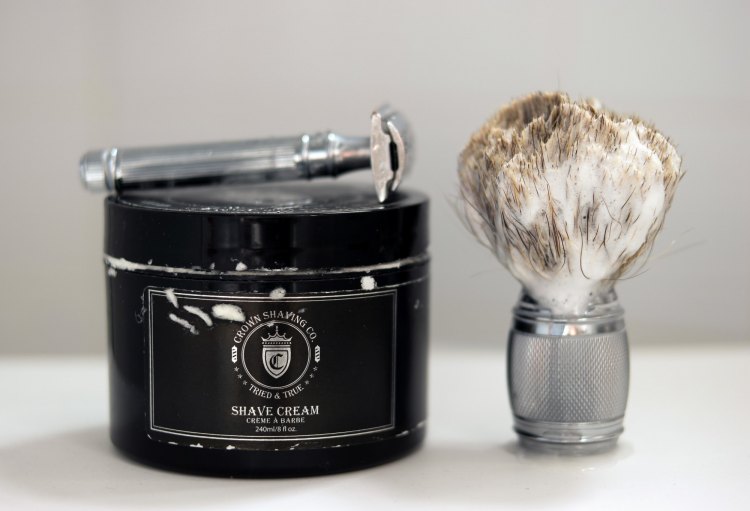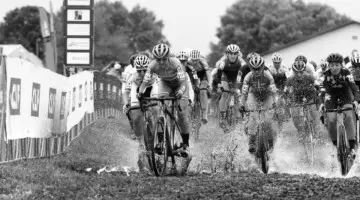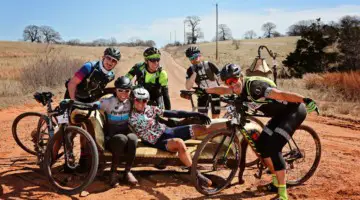 In part one of a four-part series, which originally appeared in Cyclocross Magazine Issue 29, we take a look at two cyclocross traditions that have strong opinions on both sides of the issue—leg shaving and embrocation. Read on to see what top pros have to say, and maybe you’ll reevaluate your race day prep. See Part 2’s look at pre-race caffeine and post-race massage here. (Illustration by Jeff Rosenhall)
In part one of a four-part series, which originally appeared in Cyclocross Magazine Issue 29, we take a look at two cyclocross traditions that have strong opinions on both sides of the issue—leg shaving and embrocation. Read on to see what top pros have to say, and maybe you’ll reevaluate your race day prep. See Part 2’s look at pre-race caffeine and post-race massage here. (Illustration by Jeff Rosenhall)
Traditions: these are the long-standing habits that have often stood the test of years or generations.
In some cases, traditions are instilled by a set of rules, but other times, they are simple tricks and tips passed from one athlete to the next. But just because something is ingrained in tradition doesn’t mean it equates to direct improvements in your performance. Still, there is something to be said for a race-day ritual that puts your brain into the right mindset, or a convention that acts as a podium-awarding placebo.
If a tradition works to put your nerves at rest (or pump you up to the right level), then far be it from us to tell you what works and what doesn’t. However, in this four part series, we wanted investigate eight common traditions that top-level cyclocross racers engage in, and we asked a handful of Elite racers what benefit they thought each might have for the beginner or ’cross weekend warrior.
Leg Shaving

Silky smooth or furry? The racers we interviewed seemed to look favorably on shaved legs. Photo by Flickr User Barney Bishop
For style or speed, shaving one’s legs have become one of the staunch traditions in cycling. Europeans have been shaving for generations, and many Americans have at least tried it out after watching Breaking Away. The general consensus is split. The conventional argument is that road rash is easier to clean with shaved legs, but how applicable is that to cyclocross? Perhaps the lack of gunk that comes with embrocation, and the ease of power-washing shaved legs are decent arguments—but is this tradition borne mainly out of the thrill of seeing bare muscle tone? And is this worth the money you spend on razors and time invested? Here’s what the Elites say:
Mo Bruno Roy: Shaved legs makes wound clean-up easier if you have a crash and mud clean-up easier if it’s a messy course. Worth trying to see if it works for you.
Cassie Maximenko: Shaved legs are a must. It looks better for both men and women, makes wound care easier, and even if it’s not actually faster, the placebo effect definitely has its value!
Allen Krughoff: I think this goes along with showing up with your bike washed. Could you show up with a dirty bike and kit and still get the job done? Sure. That said, it’s part of the program and has some added benefits, like making cuts and scrapes easier to manage, as well as easier to clean the mud off post-race. There are some guys out there who race at a high level and don’t shave their legs— it’s kind of like knowing grammar and punctuation and then choosing to use it incorrectly as an artistic style.
Jeremy Powers: Shaving your legs makes it easier to clean the mud and blood and guts off your legs after training or racing, but not necessarily a thing I would harp on as a must-do.
Don Myrah: Not shaving my legs is what I would call a conscious non-effort. But I should say that when I was a pro, I shaved my legs, and of all things, the team soigneur’s massage felt much better with bare legs. I heard about the benefits of the latest Specialized tests, though, so you may see a change in my habits in the near future.
Tim Johnson: Worth doing? Sure, if it helps you feel like a million bucks and the glimpse of your pale white, nearly muscular legs gives you an extra 1.3 percent in power—do it!
Josh Johnson: For cyclists, shaved legs are more of a rite of passage or an informal norm that everyone follows than a necessity, especially for a casual ’crosser. I think where shaving your legs for ’cross becomes more important is when you would be using embrocation or getting a massage; it’s also easier to wipe your legs off following a race. I shave my legs partially for function and partially for vanity.
Helen Wyman: I’m a girl, I love my legs and I love showing them off—so everyone should shave.
Embrocation

Our group of interviewees were split on warming embrocation use—take a look at their responses and decide for yourself. © Cyclocross Magazine
When you jump into the shower after a hard day of racing, you curse yourself for forgetting to wipe that embrocation off your legs before getting wet—only the curse sounds more like a gurgled scream, and your spouse in the other room might worry that the hotel uses battery acid. You thought you swore off embro after mixing it up with chamois crème, but come the next morning, you want that extra bit of heat to soothe your muscles before contesting the holeshot. Is it beneficial? Here’s what the Elites say, and if you’re convinced to go for it, be sure to check out our embrocation reviews to see which balm is best for you:
Cassie Maximenko: Definitely no embro for me. I don’t like the post-race “legs on fire” feeling, and usually I’m racing hard enough that my legs are never cold even in the worst New England conditions.
Tim Johnson: Leg warmers get thick and heavy when wet. Embro doesn’t. Be sure and apply early and absolutely make sure your shorts or skinsuit is already in place! My embrocation will burn for hours if not properly handled.
Helen Wyman: Don’t use it, unless you have really high white socks and the tanning kind. Except when it’s freezing, then it’s great on feet and hands! Oh, and when it’s cold and raining on hands, wear rubber gloves, so then your cycling gloves will last for hours. But if others don’t get biking they’ll think you’re weird!
Mo Bruno Roy: Embrocation—I don’t use it. The capsaicin in the heated blends can cause rashes, skin irritation and delayed skin “burning.” The oils in embro can become rancid over time and if the product gets hot, because most are natural and don’t have preservatives. This means it goes bad, can smell bad, and refined oils aren’t great for you. The oils and capsaicin can also break down the elastic in synthetic cycling clothes and destroy your leg and knee warmers. You may have seen this when the elastic is threadbare at the knees. As an alternative skin protectant, try a natural oil like jojoba or coconut that doesn’t go rancid or stain and damage fabrics.
As for embro, the warming effect is pretty superficial. It’s unlikely that it can penetrate the three primary layers of the skin, and their sub-layers, to get into the muscle tissue to create change. I think of embro as more of a skin protectant. The oils and wax are a physical barrier against the elements. I think a good pair of knee or leg warmers is as effective without the burn and potential skin irritation. Try a heat-free embro for skin protection without the effects from capsaicin on skin and clothing.
The superficial warming of embro feels great to lots of folks in the cold and can be used on stiff low backs or the chest to create a warming feeling that may allow you to feel more relaxed, reduce shivering and facilitate ease of movement.
Josh Johnson: I use embrocation when the weather is cooler and raining or sloppy. I’m not a die-hard user, but I like to use it to create a barrier for my skin in poor conditions. Isn’t the post-shower embro burn the best? [Although he was laughing, he sounded half-serious].
Allen Krughoff: Yes. However, I don’t believe it’s an outright substitute for proper insulation and protection layers like some people. Reasons why I use Mad Alchemy Madness, the super hot stuff, and only on race days. The combination of warmth and the nice scent helps tell my mind that it’s go time, it creates a very thin moisture barrier on the skin when it’s rainy that can be effective and much lighter than sopping wet leg warmers.
Meredith Miller: For sure. On the cold, wet days having some mild to hot embro on the legs helps cut down some of the cold sensations. On the coldest of cold days, I have also used embro on my feet! Often times on wet and/or chilly days I will use a non-warming embro to add an extra layer of protection when heat isn’t necessary. I would always prefer to use embro instead of knee or leg warmers to keep me warm and dry in a race.
See Cyclocross Magazine’s Part 2’s look at pre-race caffeine and post-race massage here




























